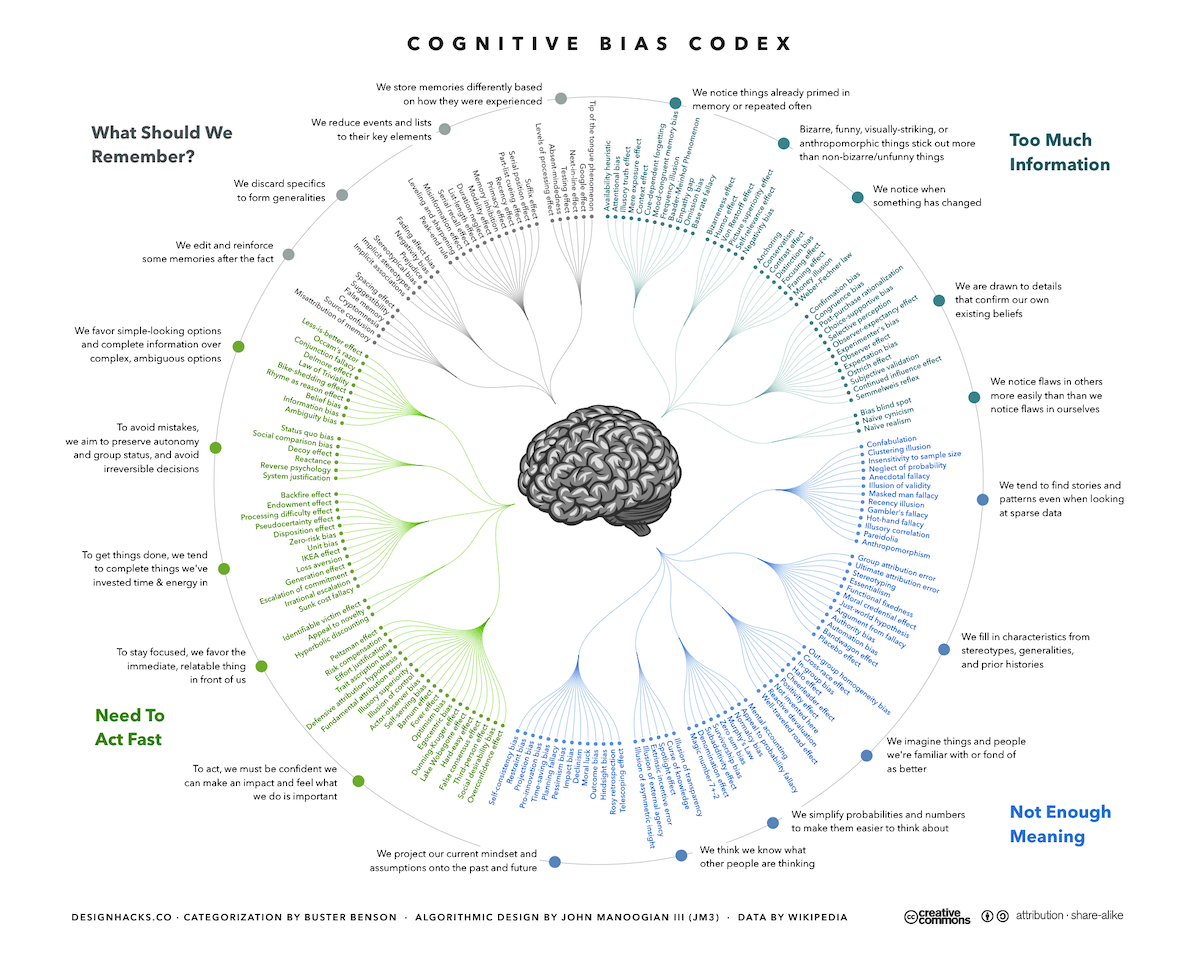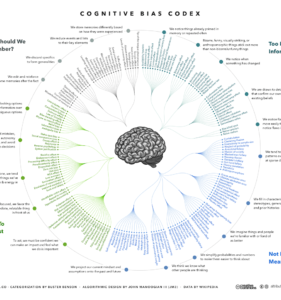The Cognitive Bias Codex is a visual representation of more than 180 cognitive biases that affect our thinking and decision-making. It was created by designer John Manoogian III in 2016, and has since become a popular tool for understanding and recognizing cognitive biases.
The codex is organised into four main categories: Problems with Information Processing, Problems with Memory, Problems with Meaning-Making, and Problems with Decision-Making. Each category contains several subcategories, and each cognitive bias is represented by a unique icon and description.
Some of the most well-known cognitive biases represented in the codex include confirmation bias, availability heuristic, anchoring bias, hindsight bias, and the sunk cost fallacy. However, the codex also includes many lesser-known biases that can be equally influential in our thinking.
The Cognitive Bias Codex is a helpful tool for anyone who wants to improve their critical thinking skills and reduce the impact of cognitive biases on decision-making. By familiarising oneself with the various cognitive biases and their icons, one can quickly recognize when these biases are at play and take steps to overcome them.
It is important to note, however, that the codex is not a comprehensive list of all cognitive biases and that the actual number of biases may be much higher. Additionally, some experts have criticised the codex for oversimplifying complex psychological phenomena and reducing them to catchy icons and slogans.
Despite these criticisms, the Cognitive Bias Codex remains a useful and accessible tool for understanding and recognizing cognitive biases. By using it as a starting point for further exploration and reflection, individuals can become more aware of their own biases and work to overcome them.
Problems with Information Processing
The category of Problems with Information Processing in the Cognitive Bias Codex includes cognitive biases that affect the way we process and interpret information. Here are some examples of biases in this category:
- Confirmation bias: The tendency to seek out information that confirms our existing beliefs and ignore evidence that contradicts them. This bias can lead to selective attention, interpretation, and memory of information that is consistent with our beliefs, while disregarding information that challenges them.
- Availability heuristic: The tendency to rely on easily accessible information when making decisions, rather than considering all available evidence. This bias can lead to overestimating the likelihood of events that are more vivid, memorable, or recently experienced, while underestimating events that are less salient.
- Illusory correlation: The tendency to perceive a relationship between two variables that are actually unrelated or only weakly related. This bias can occur when people have a preconceived notion that two variables are related, and they selectively attend to information that confirms this notion while ignoring contradictory information.
- Negativity bias: The tendency to focus more on negative information than positive information. This bias can lead to overestimating the likelihood and impact of negative events, while underestimating the likelihood and impact of positive events.
- Outcome bias: The tendency to judge the quality of a decision based on its outcome, rather than on the information that was available at the time the decision was made. This bias can lead to ignoring the role of chance, uncertainty, and unforeseeable events in the outcome of a decision, and to overestimating the accuracy and usefulness of hindsight.
- Framing effect: The way information is presented can influence our decisions. This bias occurs when people’s decisions are influenced by how information is framed or presented, rather than the information itself.
These are just a few examples of cognitive biases that fall under the category of Problems with Information Processing. By becoming aware of these biases and how they affect our thinking, we can take steps to overcome them and make more informed and objective decisions.
Problems with Memory
The category of Problems with Memory in the Cognitive Bias Codex includes cognitive biases that affect the way we remember past events and experiences. Here are some examples of biases in this category:
- Hindsight bias: The tendency to overestimate our ability to predict an event after it has occurred. This bias can lead people to believe that they knew something was going to happen all along, even if they did not actually predict it.
- Telescoping effect: The tendency to remember recent events as occurring more distantly in the past, and distant events as occurring more recently. This bias can affect our perceptions of the passage of time and can lead to inaccurate memories.
- Misinformation effect: The tendency to incorporate misleading information into our memories of past events. This bias can occur when people are exposed to new information after an event has occurred, which can distort their memory of the original event.
- Suggestibility: The tendency to incorporate suggestions from others into our memories of past events. This bias can occur when people are asked leading questions or given false information that can influence their memory.
- Self-serving bias: The tendency to remember past events in a way that supports our self-image or goals. This bias can lead people to remember their own successes more vividly than their failures and to attribute their successes to internal factors, while attributing their failures to external factors.
- Reminiscence bump: The tendency to remember events that occurred during adolescence and early adulthood more vividly than events that occurred later in life. This bias can be influenced by the importance of these events in shaping our identity and life trajectory.
These are just a few examples of cognitive biases that fall under the category of Problems with Memory. By becoming aware of these biases and how they affect our memory and perception of past events, we can take steps to avoid inaccuracies and make more objective and accurate decisions.
Problems with Meaning-Making
The category of Problems with Meaning-Making in the Cognitive Bias Codex includes cognitive biases that affect the way we interpret and make meaning of information. Here are some examples of biases in this category:
- Fundamental attribution error: The tendency to attribute the behaviour of others to their character or personality, rather than to external circumstances. This bias can lead to overestimating the role of personal traits and underestimating the role of situational factors in determining behaviour.
- Actor-observer bias: The tendency to attribute our own behaviour to external circumstances, while attributing the behaviour of others to their character or personality. This bias can lead to a lack of empathy and understanding of the perspective of others.
- Self-fulfilling prophecy: The tendency to behave in ways that confirm our expectations or beliefs about a situation or person. This bias can lead to a reinforcing cycle of behaviour and expectations that can perpetuate stereotypes and biases.
- Just-world fallacy: The tendency to believe that the world is a just place where people get what they deserve. This bias can lead to victim blaming and a lack of empathy for people who experience misfortune.
- False consensus effect: The tendency to overestimate the extent to which others share our beliefs, attitudes, and behaviours. This bias can lead to a lack of diversity of thought and a reluctance to consider alternative perspectives.
- Stereotyping: The tendency to make assumptions about people based on their membership in a particular group, rather than on individual characteristics or behaviour. This bias can lead to discrimination and a lack of empathy and understanding of individual differences.
These are just a few examples of cognitive biases that fall under the category of Problems with Meaning-Making. By becoming aware of these biases and how they affect our interpretation and meaning-making of information, we can take steps to avoid stereotypes and biases and make more objective and accurate decisions.
Problems with Decision-Making
The category of Problems with Decision-Making in the Cognitive Bias Codex includes cognitive biases that affect the way we make decisions. Here are some examples of biases in this category:
- Overconfidence bias: The tendency to overestimate our own abilities and the accuracy of our judgments. This bias can lead to poor decision-making and a lack of consideration of alternative perspectives.
- Status quo bias: The tendency to prefer the current state of affairs over alternative options. This bias can lead to resistance to change and a lack of innovation.
- Anchoring bias: The tendency to rely too heavily on the first piece of information encountered when making a decision. This bias can lead to an over-reliance on initial impressions and a failure to consider alternative perspectives.
- Sunk cost fallacy: The tendency to continue investing in a project or decision based on past investments, even if the future prospects are poor. This bias can lead to a lack of flexibility and a failure to cut losses when necessary.
- Groupthink: The tendency for members of a group to conform to the group’s norms and beliefs, rather than considering alternative perspectives. This bias can lead to a lack of diversity of thought and a failure to consider all available evidence.
- Choice-supportive bias: The tendency to retroactively justify a decision by focusing on its positive aspects and ignoring its negative aspects. This bias can lead to a lack of self-reflection and a failure to learn from past mistakes.
These are just a few examples of cognitive biases that fall under the category of Problems with Decision-Making. By becoming aware of these biases and how they affect our decision-making, we can take steps to avoid biases and make more objective and accurate decisions.


